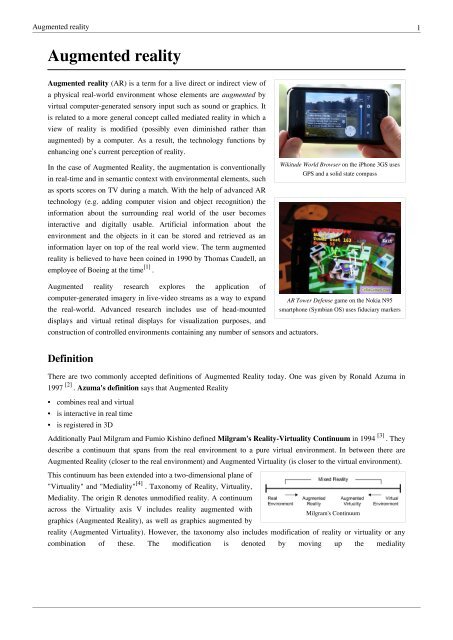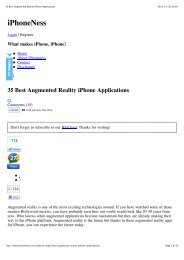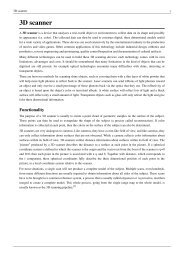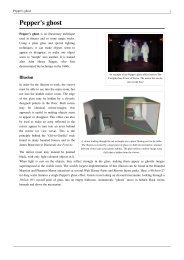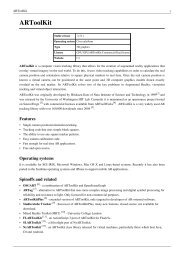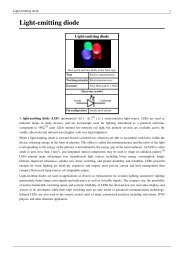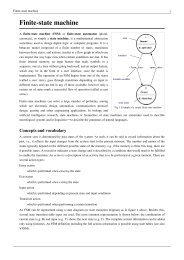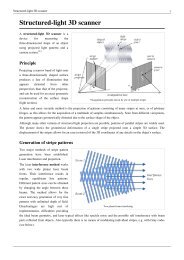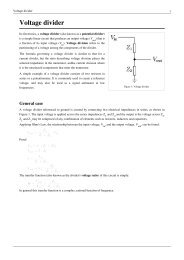Augmented reality - Wikipedia, the free encyclopedia.pdf - Ex-ch.com
Augmented reality - Wikipedia, the free encyclopedia.pdf - Ex-ch.com
Augmented reality - Wikipedia, the free encyclopedia.pdf - Ex-ch.com
You also want an ePaper? Increase the reach of your titles
YUMPU automatically turns print PDFs into web optimized ePapers that Google loves.
<strong>Augmented</strong> <strong>reality</strong> 1<br />
<strong>Augmented</strong> <strong>reality</strong><br />
<strong>Augmented</strong> <strong>reality</strong> (AR) is a term for a live direct or indirect view of<br />
a physical real-world environment whose elements are augmented by<br />
virtual <strong>com</strong>puter-generated sensory input su<strong>ch</strong> as sound or graphics. It<br />
is related to a more general concept called mediated <strong>reality</strong> in whi<strong>ch</strong> a<br />
view of <strong>reality</strong> is modified (possibly even diminished ra<strong>the</strong>r than<br />
augmented) by a <strong>com</strong>puter. As a result, <strong>the</strong> te<strong>ch</strong>nology functions by<br />
enhancing one’s current perception of <strong>reality</strong>.<br />
In <strong>the</strong> case of <strong>Augmented</strong> Reality, <strong>the</strong> augmentation is conventionally<br />
in real-time and in semantic context with environmental elements, su<strong>ch</strong><br />
as sports scores on TV during a mat<strong>ch</strong>. With <strong>the</strong> help of advanced AR<br />
te<strong>ch</strong>nology (e.g. adding <strong>com</strong>puter vision and object recognition) <strong>the</strong><br />
information about <strong>the</strong> surrounding real world of <strong>the</strong> user be<strong>com</strong>es<br />
interactive and digitally usable. Artificial information about <strong>the</strong><br />
environment and <strong>the</strong> objects in it can be stored and retrieved as an<br />
information layer on top of <strong>the</strong> real world view. The term augmented<br />
<strong>reality</strong> is believed to have been coined in 1990 by Thomas Caudell, an<br />
employee of Boeing at <strong>the</strong> time [1] .<br />
<strong>Augmented</strong> <strong>reality</strong> resear<strong>ch</strong> explores <strong>the</strong> application of<br />
<strong>com</strong>puter-generated imagery in live-video streams as a way to expand<br />
<strong>the</strong> real-world. Advanced resear<strong>ch</strong> includes use of head-mounted<br />
displays and virtual retinal displays for visualization purposes, and<br />
construction of controlled environments containing any number of sensors and actuators.<br />
Definition<br />
Wikitude World Browser on <strong>the</strong> iPhone 3GS uses<br />
GPS and a solid state <strong>com</strong>pass<br />
AR Tower Defense game on <strong>the</strong> Nokia N95<br />
smartphone (Symbian OS) uses fiduciary markers<br />
There are two <strong>com</strong>monly accepted definitions of <strong>Augmented</strong> Reality today. One was given by Ronald Azuma in<br />
1997 [2] . Azuma's definition says that <strong>Augmented</strong> Reality<br />
• <strong>com</strong>bines real and virtual<br />
• is interactive in real time<br />
• is registered in 3D<br />
Additionally Paul Milgram and Fumio Kishino defined Milgram's Reality-Virtuality Continuum in 1994 [3] . They<br />
describe a continuum that spans from <strong>the</strong> real environment to a pure virtual environment. In between <strong>the</strong>re are<br />
<strong>Augmented</strong> Reality (closer to <strong>the</strong> real environment) and <strong>Augmented</strong> Virtuality (is closer to <strong>the</strong> virtual environment).<br />
This continuum has been extended into a two-dimensional plane of<br />
"Virtuality" and "Mediality" [4] . Taxonomy of Reality, Virtuality,<br />
Mediality. The origin R denotes unmodified <strong>reality</strong>. A continuum<br />
across <strong>the</strong> Virtuality axis V includes <strong>reality</strong> augmented with<br />
graphics (<strong>Augmented</strong> Reality), as well as graphics augmented by<br />
Milgram's Continuum<br />
<strong>reality</strong> (<strong>Augmented</strong> Virtuality). However, <strong>the</strong> taxonomy also includes modification of <strong>reality</strong> or virtuality or any<br />
<strong>com</strong>bination of <strong>the</strong>se. The modification is denoted by moving up <strong>the</strong> mediality
<strong>Augmented</strong> <strong>reality</strong> 2<br />
axis. Fur<strong>the</strong>r up this axis, for example, we can find mediated<br />
<strong>reality</strong>, mediated virtuality, or any <strong>com</strong>bination of <strong>the</strong>se. Fur<strong>the</strong>r<br />
up and to <strong>the</strong> right we have virtual worlds that are responsive to a<br />
severely modified version of <strong>reality</strong>. (at right) Mediated <strong>reality</strong><br />
generalizes <strong>the</strong> concepts of mixed <strong>reality</strong>, etc.. It includes <strong>the</strong><br />
virtuality <strong>reality</strong> continuum (mixing) but also, in addition to<br />
additive effects, also includes multiplicative effects (modulation)<br />
of (sometimes deliberately) diminished <strong>reality</strong>. Moreover, it<br />
considers, more generally, that <strong>reality</strong> may be modified in various<br />
ways. The mediated <strong>reality</strong> framework describes devices that<br />
deliberately modify <strong>reality</strong>, as well as devices that accidentally<br />
modify it.<br />
More recently, <strong>the</strong> term augmented <strong>reality</strong> has been blurred a bit<br />
due to <strong>the</strong> increased interest of <strong>the</strong> general public in AR.<br />
<strong>Ex</strong>amples<br />
Mediated Reality continuum showing four points:<br />
<strong>Augmented</strong> Reality, <strong>Augmented</strong> Virtuality, Mediated<br />
Reality, and Mediated Virtuality on <strong>the</strong> Virtuality and<br />
Mediality axes<br />
Commonly known examples of AR are <strong>the</strong> yellow "first down" lines seen in television broadcasts of American<br />
football games using <strong>the</strong> 1st & Ten system, and <strong>the</strong> colored trail showing location and direction of <strong>the</strong> puck in TV<br />
broadcasts of ice hockey games. The real-world elements are <strong>the</strong> football field and players, and <strong>the</strong> virtual element is<br />
<strong>the</strong> yellow line, whi<strong>ch</strong> is drawn over <strong>the</strong> image by <strong>com</strong>puters in real time. Similarly, rugby fields and cricket pit<strong>ch</strong>es<br />
are branded by <strong>the</strong>ir sponsors using <strong>Augmented</strong> Reality; giant logos are inserted onto <strong>the</strong> fields when viewed on<br />
television. In some cases, <strong>the</strong> modification of <strong>reality</strong> goes beyond mere augmentation. For example, advertisements<br />
may be blocked out (partially or wholly diminished) and replaced with different advertisements. Su<strong>ch</strong> replacement is<br />
an example of Mediated <strong>reality</strong>, a more general concept than AR.<br />
Television telecasts of swimming events also often have a virtual line whi<strong>ch</strong> indicates <strong>the</strong> position of <strong>the</strong> current<br />
world record holder at that time.<br />
Ano<strong>the</strong>r type of AR application uses projectors and screens to insert objects into <strong>the</strong> real environment, enhancing<br />
museum exhibitions for example. The difference from a simple TV screen for example, is that <strong>the</strong>se objects are<br />
related to <strong>the</strong> environment of <strong>the</strong> screen or display, and that <strong>the</strong>y often are interactive as well.<br />
Many first-person shooter video games simulate <strong>the</strong> viewpoint of someone using AR systems. In <strong>the</strong>se games <strong>the</strong> AR<br />
can be used to give visual directions to a location, mark <strong>the</strong> direction and distance of ano<strong>the</strong>r person who is not in<br />
line of sight, give information about equipment su<strong>ch</strong> as remaining bullets in a gun, and display a myriad of o<strong>the</strong>r<br />
images based on whatever <strong>the</strong> game designers intend. This is also called <strong>the</strong> head-up display.<br />
In some current applications like in cars or airplanes, this is usually a head-up display integrated into <strong>the</strong> windshield.<br />
The F-35 Lightning II has no head-up display. This is because all targets are tracked by <strong>the</strong> aircraft's situational<br />
awareness and <strong>the</strong> sensor fusion is presented in <strong>the</strong> pilot's helmet mounted display. The helmet mounted display<br />
provides an augmented <strong>reality</strong> system that allows <strong>the</strong> pilot to look through his own aircraft as if it wasn't <strong>the</strong>re. [5]
<strong>Augmented</strong> <strong>reality</strong> 3<br />
History<br />
• 1957-62: Morton Heilig, a cinematographer, creates and patents a simulator called Sensorama with visuals, sound,<br />
vibration, and smell. [6]<br />
• 1966: Ivan Su<strong>the</strong>rland invents <strong>the</strong> head-mounted display suggesting it was a window into a virtual world.<br />
• 1975: Myron Krueger creates Videoplace that allows users to interact with virtual objects for <strong>the</strong> first time.<br />
• 1989: Jaron Lanier coins <strong>the</strong> phrase Virtual Reality and creates <strong>the</strong> first <strong>com</strong>mercial business around virtual<br />
worlds.<br />
• 1992: Tom Caudell [7] coins <strong>the</strong> phrase <strong>Augmented</strong> Reality while at Boeing helping workers assemble cables<br />
into aircraft.<br />
• 1992: L.B. Rosenberg develops one of <strong>the</strong> first functioning AR systems, called VIRTUAL FIXTURES, at <strong>the</strong><br />
[8] [9]<br />
U.S. Air Force Armstrong Labs, and demonstrates benefit on human performance.<br />
• 1992: Steven Feiner, Blair MacIntyre and Doree Seligmann present first major paper on an AR system prototype,<br />
KARMA, at <strong>the</strong> Graphics Interface conference. Widely cited version of <strong>the</strong> paper is published in Communications<br />
of <strong>the</strong> ACM next year.<br />
• 1994: Julie Martin creates first <strong>Augmented</strong> Reality Theater production,Dancing In Cyberspace funded by<br />
Australian Federal Government, Australia Council For The ArtsFeatures, dancers and acrobats manipulating full<br />
body sized virtual object in real time, projected into <strong>the</strong> same physical space and performance plane. The acrobats<br />
appeared immersed within <strong>the</strong> virtual object and environments. naked eye installation powered by Silicon Graphic<br />
Computer and Polhemus sensing system.<br />
• 1999: Hirokazu Kato (加藤 博一) created ARToolKit at HITLab, where AR later is fur<strong>the</strong>r developed by o<strong>the</strong>r<br />
HITLab scientists and it is demonstrated at SIGGRAPH that year.<br />
• 2000: Bruce H. Thomas develops ARQuake, <strong>the</strong> first outdoor mobile AR game, and is demonstrated in <strong>the</strong><br />
International Symposium on Wearable Computers.<br />
• 2008: Wikitude AR Travel Guide [10] laun<strong>ch</strong>es on Oct. 20, 2008 with <strong>the</strong> G1 Android phone.<br />
• 2009: Wikitude Drive - AR Navigation System laun<strong>ch</strong>es on Oct. 28, 2009 for <strong>the</strong> Android platform.<br />
• 2009: AR Toolkit is ported to Adobe Flash (FLARToolkit) by Saqoosha [11] , bringing augmented <strong>reality</strong> to <strong>the</strong><br />
web browser.<br />
Te<strong>ch</strong>nology<br />
Hardware<br />
The main hardware <strong>com</strong>ponents for augmented <strong>reality</strong> are: display, tracking, input devices, and <strong>com</strong>puter.<br />
Combination of powerful CPU, camera, accelerometers, GPS and solid state <strong>com</strong>pass are often present in modern<br />
smartphones, whi<strong>ch</strong> make <strong>the</strong>m prospective platforms for augmented <strong>reality</strong>.<br />
Display<br />
There are three major display te<strong>ch</strong>niques for <strong>Augmented</strong> Reality:<br />
I. Head Mounted Displays<br />
II. Handheld Displays<br />
III. Spatial Displays
<strong>Augmented</strong> <strong>reality</strong> 4<br />
Head Mounted Displays<br />
A Head Mounted Display (HMD) places images of both <strong>the</strong> physical world and registered virtual graphical objects<br />
over <strong>the</strong> user's view of <strong>the</strong> world. The HMD's are ei<strong>the</strong>r optical see-through or video see-through in nature. An<br />
optical see-through display employs half-silver mirror te<strong>ch</strong>nology to allow views of physical world to pass through<br />
<strong>the</strong> lens and graphical overlay information to be reflected into <strong>the</strong> user's eyes. The HMD must be tracked with a six<br />
degree of <strong>free</strong>dom sensor.This tracking allows for <strong>the</strong> <strong>com</strong>puting system to register <strong>the</strong> virtual information to <strong>the</strong><br />
physical world. The main advantage of HMD AR is <strong>the</strong> immersive experience for <strong>the</strong> user. The graphical<br />
information is slaved to <strong>the</strong> view of <strong>the</strong> user. The most <strong>com</strong>mon products employed are as follows: MicroVision<br />
Nomad, Sony Glasstron, Vuzix AR [12] and I/O Displays.<br />
Handheld Displays<br />
Handheld Augment Reality employs a small <strong>com</strong>puting device with a display that fits in a user's hand. All handheld<br />
AR solutions to date have employed video see-through te<strong>ch</strong>niques to overlay <strong>the</strong> graphical information to <strong>the</strong><br />
physical world. Initially handheld AR employed sensors su<strong>ch</strong> as digital <strong>com</strong>passes and GPS units for its six degree<br />
of <strong>free</strong>dom tracking sensors. This moved onto <strong>the</strong> use of fiducial marker systems su<strong>ch</strong> as <strong>the</strong> ARToolKit for<br />
tracking. Today vision systems su<strong>ch</strong> as SLAM or PTAM are being employed for tracking. Handheld display AR<br />
promises to be <strong>the</strong> first <strong>com</strong>mercial success for AR te<strong>ch</strong>nologies. The two main advantages of handheld AR is <strong>the</strong><br />
portable nature of handheld devices and ubiquitous nature of camera phones.<br />
Spatial Displays<br />
Instead of <strong>the</strong> user wearing or carrying <strong>the</strong> display su<strong>ch</strong> as with head mounted displays or handheld devices; Spatial<br />
<strong>Augmented</strong> Reality (SAR) makes use of digital projectors to display graphical information onto physical objects.<br />
The key difference in SAR is that <strong>the</strong> display is separated from <strong>the</strong> users of <strong>the</strong> system. Because <strong>the</strong> displays are not<br />
associated with ea<strong>ch</strong> user, SAR scales naturally up to groups of users, thus allowing for collocated collaboration<br />
between users. SAR has several advantages over traditional head mounted displays and handheld devices. The user<br />
is not required to carry equipment or wear <strong>the</strong> display over <strong>the</strong>ir eyes. This makes spatial AR a good candidate for<br />
collaborative work, as <strong>the</strong> users can see ea<strong>ch</strong> o<strong>the</strong>r’s faces. A system can be used by multiple people at <strong>the</strong> same time<br />
without ea<strong>ch</strong> having to wear a head mounted display. Spatial AR does not suffer from <strong>the</strong> limited display resolution<br />
of current head mounted displays and portable devices. A projector based display system can simply incorporate<br />
more projectors to expand <strong>the</strong> display area. Where portable devices have a small window into <strong>the</strong> world for drawing,<br />
a SAR system can display on any number of surfaces of an indoor setting at once. The tangible nature of SAR makes<br />
this an ideal te<strong>ch</strong>nology to support design, as SAR supports both a graphical visualisation and passive haptic<br />
sensation for <strong>the</strong> end users. People are able to tou<strong>ch</strong> physical objects, and it is this process that provides <strong>the</strong> passive<br />
[2] [13] [14] [15]<br />
haptic sensation.<br />
Tracking<br />
Modern mobile augmented <strong>reality</strong> systems use one or more of <strong>the</strong> following tracking te<strong>ch</strong>nologies: digital cameras<br />
and/or o<strong>the</strong>r optical sensors, accelerometers, GPS, gyroscopes, solid state <strong>com</strong>passes, RFID, wireless sensors. Ea<strong>ch</strong><br />
of <strong>the</strong>se te<strong>ch</strong>nologies have different levels of accuracy and precision. Most important is <strong>the</strong> tracking of <strong>the</strong> pose and<br />
position of <strong>the</strong> user's head for <strong>the</strong> augmentation of <strong>the</strong> user's view. The user's hand(s) can be tracked or a handheld<br />
input device could be tracked to provide a 6DOF interaction te<strong>ch</strong>nique. Stationary systems can employ 6DOF track<br />
systems su<strong>ch</strong> as Polhemus, ViCON, A.R.T, or Ascension.
<strong>Augmented</strong> <strong>reality</strong> 5<br />
Input devices<br />
This is a current open resear<strong>ch</strong> question. Some systems, su<strong>ch</strong> as <strong>the</strong> Tinmith system, employ pin<strong>ch</strong> glove te<strong>ch</strong>niques.<br />
Ano<strong>the</strong>r <strong>com</strong>mon te<strong>ch</strong>nique is a wand with a button on it. In case of a smartphone, <strong>the</strong> phone itself could be used as<br />
3D pointing device, with 3D position of <strong>the</strong> phone restored from <strong>the</strong> camera images.<br />
Computer<br />
Camera based systems require powerful CPU and considerable amount of RAM for processing camera images.<br />
Wearable <strong>com</strong>puting systems employ a laptop in a backpack configuration. For stationary systems a traditional<br />
workstation with a powerful graphics card. Sound processing hardware could be included in augmented <strong>reality</strong><br />
systems.<br />
Software<br />
For consistent merging real-world images from camera and virtual 3D images, virtual images should be atta<strong>ch</strong>ed to<br />
real-world locations in visually realistic way. That means a real world coordinate system, independent from <strong>the</strong><br />
camera, should be restored from camera images. That process is called Image registration and is part of Azuma's<br />
definition of <strong>Augmented</strong> Reality.<br />
<strong>Augmented</strong> <strong>reality</strong> image registration uses different methods of <strong>com</strong>puter vision, mostly related to video tracking.<br />
Many <strong>com</strong>puter vision methods of augmented <strong>reality</strong> are inherited form similar visual odometry methods.<br />
Usually those methods consist of two parts. First interest points, or fiduciary markers, or optical flow detected in <strong>the</strong><br />
camera images. First stage can use Feature detection methods like Corner detection, Blob detection, Edge detection<br />
or thresholding and/or o<strong>the</strong>r image processing methods.<br />
In <strong>the</strong> second stage, a real world coordinate system is restored from <strong>the</strong> data obtained in <strong>the</strong> first stage. Some<br />
methods assume objects with known 3D geometry(or fiduciary markers) present in <strong>the</strong> scene and make use of those<br />
data. In some of those cases all of <strong>the</strong> scene 3D structure should be precalculated beforehand. If not all of <strong>the</strong> scene is<br />
known beforehand SLAM te<strong>ch</strong>nique could be used for mapping fiduciary markers/3D models relative positions. If<br />
no assumption about 3D geometry of <strong>the</strong> scene made structure from motion methods are used. Methods used in <strong>the</strong><br />
second stage include projective(epipolar) geometry, bundle adjustment, rotation representation with exponential<br />
map, kalman and particle filters.<br />
Applications<br />
Current applications<br />
Advertising: Marketers started to use AR to promote products via interactive AR applications. For example, at <strong>the</strong><br />
2008 LA Auto Show, Nissan unveiled <strong>the</strong> concept vehicle Cube and presented visitors with a bro<strong>ch</strong>ure whi<strong>ch</strong>, when<br />
held against a webcam, showed several versions of <strong>the</strong> vehicle [16] . In August 2009,discrepancies Best Buy ran a<br />
circular with an augmented <strong>reality</strong> code that allowed users with a webcam to interact with <strong>the</strong> product in 3D. [17] In<br />
2010 Walt Disney used mobile augmented <strong>reality</strong> to connect [18] a movie experience to outdoor advertising.<br />
Support with <strong>com</strong>plex tasks: Complex tasks su<strong>ch</strong> as assembly, maintenance, and surgery can be simplified by<br />
inserting additional information into <strong>the</strong> field of view. For example, labels can be displayed on parts of a system to<br />
clarify operating instructions for a me<strong>ch</strong>anic who is performing maintenance on <strong>the</strong> system. [19] [20] AR can include<br />
images of hidden objects, whi<strong>ch</strong> can be particularly effective for medical diagnostics or surgery. <strong>Ex</strong>amples include a<br />
virtual X-ray view based on prior tomography or on real time images from ultrasound and microconfocal probes [21]<br />
or open NMR devices. A doctor could observe <strong>the</strong> fetus inside <strong>the</strong> mo<strong>the</strong>r's womb [22] . See also Mixed <strong>reality</strong>.<br />
Navigation devices: AR can augment <strong>the</strong> effectiveness of navigation devices for a variety of applications. For<br />
example, building navigation can be enhanced for <strong>the</strong> purpose of maintaining industrial plants. Outdoor navigation
<strong>Augmented</strong> <strong>reality</strong> 6<br />
can be augmented for military operations or disaster management. Head-up displays or personal display glasses in<br />
automobiles can be used to provide navigation hints and traffic information. These types of displays can be useful for<br />
airplane pilots, too. Head-up displays are currently used in fighter jets as one of <strong>the</strong> first AR applications. These<br />
include full interactivity, including eye pointing.<br />
Industrial Applications: AR can be used to <strong>com</strong>pare <strong>the</strong> data of digital mock-ups with physical mock-ups for<br />
efficiently finding discrepancies between <strong>the</strong> two sources. It can fur<strong>the</strong>r be employed to safeguard digital data in<br />
<strong>com</strong>bination with existing real prototypes, and thus save or minimize <strong>the</strong> building of real prototypes and improve <strong>the</strong><br />
quality of <strong>the</strong> final product.<br />
Military and emergency services: AR can be applied to military and emergency services as wearable systems to<br />
provide information su<strong>ch</strong> as instructions, maps, enemy locations, and fire cells.<br />
Prospecting: In <strong>the</strong> fields of hydrology, ecology, and geology, AR can be used to display an interactive analysis of<br />
terrain <strong>ch</strong>aracteristics. Users could use, and collaboratively modify and analyze, interactive three-dimensional maps.<br />
Art: AR can be incorporated into artistic applications that allow artists to create art in real time over <strong>reality</strong> su<strong>ch</strong> as<br />
painting, drawing, modeling, etc. One su<strong>ch</strong> example of this phenomenon is called Eyewriter that was developed in<br />
2009 by Za<strong>ch</strong>ary Lieberman and a group formed by members of Free Art and Te<strong>ch</strong>nology (FAT), OpenFrameworks<br />
and <strong>the</strong> Graffiti Resear<strong>ch</strong> Lab to help a graffiti artist, who became paralyzed, draw again. [23]<br />
Ar<strong>ch</strong>itecture: AR can be employed to simulate planned construction projects. [24]<br />
Sightseeing: Models may be created to include labels or text related to <strong>the</strong> objects/places visited. With AR, users can<br />
rebuild ruins, buildings, or even landscapes as <strong>the</strong>y previously existed. [25]<br />
Collaboration: AR can help facilitate collaboration among distributed team members via conferences with real and<br />
virtual participants. The Hand of God is a good example of a collaboration system [26] Also see Mixed <strong>reality</strong>.<br />
Entertainment and education: AR can be used in <strong>the</strong> fields of entertainment and education to create virtual objects<br />
in museums and exhibitions, <strong>the</strong>me park attractions (su<strong>ch</strong> as Cadbury World), games (su<strong>ch</strong> as ARQuake) and<br />
books [27] . Also see Mixed <strong>reality</strong>.<br />
Music: Pop group Duran Duran included interactive AR projections into <strong>the</strong>ir stage show during <strong>the</strong>ir 2000 Pop<br />
Trash concert tour. [28] Sydney band Lost Valentinos laun<strong>ch</strong>ed <strong>the</strong> world's first interactive AR music video on 16<br />
October 2009, where users could print out 5 markers representing a pre-recorded performance from ea<strong>ch</strong> band<br />
member whi<strong>ch</strong> <strong>the</strong>y could interact with live and in real-time via <strong>the</strong>ir <strong>com</strong>puter webcam and record as <strong>the</strong>ir own<br />
[29] [30]<br />
unique music video clips to share via YouTube.<br />
Future applications<br />
It is important to note that augmented <strong>reality</strong> is a costly development in te<strong>ch</strong>nology. Because of this, <strong>the</strong> future of AR<br />
is dependent on whe<strong>the</strong>r or not those costs can be reduced in some way. If AR te<strong>ch</strong>nology be<strong>com</strong>es affordable, it<br />
could be very widespread but for now major industries are <strong>the</strong> sole buyers that have <strong>the</strong> opportunity to utilize this<br />
resource.<br />
• <strong>Ex</strong>panding a PC screen into <strong>the</strong> real environment: program windows and icons appear as virtual devices in real<br />
space and are eye or gesture operated, by gazing or pointing. A single personal display (glasses) could<br />
concurrently simulate a hundred conventional PC screens or application windows all around a user<br />
• Virtual devices of all kinds, e.g. replacement of traditional screens, control panels, and entirely new applications<br />
impossible in "real" hardware, like 3D objects interactively <strong>ch</strong>anging <strong>the</strong>ir shape and appearance based on <strong>the</strong><br />
current task or need.<br />
• Enhanced media applications, like pseudo holographic virtual screens, virtual surround cinema, virtual 'holodecks'<br />
(allowing <strong>com</strong>puter-generated imagery to interact with live entertainers and audience)<br />
• Virtual conferences in "holodeck" style
<strong>Augmented</strong> <strong>reality</strong> 7<br />
• Replacement of cellphone and car navigator screens: eye-dialing, insertion of information directly into <strong>the</strong><br />
environment, e.g. guiding lines directly on <strong>the</strong> road, as well as enhancements like "X-ray"-views<br />
• Virtual plants, wallpapers, panoramic views, artwork, decorations, illumination etc., enhancing everyday life. For<br />
example, a virtual window could be displayed on a regular wall showing a live feed of a camera placed on <strong>the</strong><br />
exterior of <strong>the</strong> building, thus allowing <strong>the</strong> user to effectually toggle a wall's transparency<br />
• With AR systems getting into mass market, we may see virtual window dressings, posters, traffic signs, Christmas<br />
decorations, advertisement towers and more. These may be fully interactive even at a distance, by eye pointing for<br />
example.<br />
• Virtual gadgetry be<strong>com</strong>es possible. Any physical device currently produced to assist in data-oriented tasks (su<strong>ch</strong><br />
as <strong>the</strong> clock, radio, PC, arrival/departure board at an airport, stock ticker, PDA, PMP, informational<br />
posters/fliers/billboards, in-car navigation systems, etc.) could be replaced by virtual devices that cost nothing to<br />
produce aside from <strong>the</strong> cost of writing <strong>the</strong> software. <strong>Ex</strong>amples might be a virtual wall clock, a to-do list for <strong>the</strong><br />
day docked by your bed for you to look at first thing in <strong>the</strong> morning, etc.<br />
• Subscribable group-specific AR feeds. For example, a manager on a construction site could create and dock<br />
instructions including diagrams in specific locations on <strong>the</strong> site. The workers could refer to this feed of AR items<br />
as <strong>the</strong>y work. Ano<strong>the</strong>r example could be patrons at a public event subscribing to a feed of direction and<br />
information oriented AR items.<br />
• AR systems can help <strong>the</strong> visually impaired navigate in a mu<strong>ch</strong> better manner (<strong>com</strong>bined with a text-to-spee<strong>ch</strong><br />
software).<br />
• Computer games whi<strong>ch</strong> make use of position and environment information to place virtual objects, opponents,<br />
and weapons overlaid in <strong>the</strong> player's visual field.<br />
Notable resear<strong>ch</strong>ers<br />
• Ivan Su<strong>the</strong>rland invented <strong>the</strong> first AR head mounted display at Harvard University.<br />
• Steven Feiner, Professor at Columbia University, is a leading pioneer of augmented <strong>reality</strong>, and author of <strong>the</strong> first<br />
paper on an AR system prototype, KARMA (<strong>the</strong> Knowledge-based <strong>Augmented</strong> Reality Maintenance Assistant),<br />
along with Blair MacIntyre and Doree Seligmann. [31]<br />
• L.B. Rosenberg developed one of <strong>the</strong> first known AR systems, called Virtual Fixtures, while working at <strong>the</strong> U.S.<br />
Air Force Armstrong Labs in 1991, and published first study of how an AR system can enhance human<br />
[8] [9]<br />
performance.<br />
• Mark Billinghurst and Daniel Wagner jump started <strong>the</strong> field of AR on mobile phones. They developed <strong>the</strong> first<br />
marker tracking systems for mobile phones and PDAs. [32]<br />
• Bruce H. Thomas and Wayne Piekarski develop <strong>the</strong> Tinmith system in 1998. [33] They along with Steve Feiner<br />
with his MARS system pioneer outdoor augmented <strong>reality</strong>.<br />
Conferences<br />
• 1st International Workshop on <strong>Augmented</strong> Reality, IWAR'98, San Francisco, Nov. 1998.<br />
• 2nd International Workshop on <strong>Augmented</strong> Reality (IWAR'99 [34] ), San Francisco, Oct. 1999.<br />
• 1st International Symposium on Mixed Reality (ISMR'99), Yokohama, Japan, Mar<strong>ch</strong> 1999.<br />
• 2nd International Symposium on Mixed Reality (ISMR'01), Yokohama, Japan, Mar<strong>ch</strong> 2001.<br />
• 1st International Symposium on <strong>Augmented</strong> Reality (ISAR 2000 [35] ), Muni<strong>ch</strong>, Oct. 2000.<br />
• 2nd International Symposium on <strong>Augmented</strong> Reality (ISAR 2001 [36] ), New York, Oct. 2001.<br />
• 1st International Symposium on Mixed and <strong>Augmented</strong> Reality (ISMAR 2002 [37] ), Darmstadt, Oct. 2002.<br />
• 2nd International Symposium on Mixed and <strong>Augmented</strong> Reality (ISMAR 2003 [38] ), Tokyo, Oct. 2003.<br />
• 3rd International Symposium on Mixed and <strong>Augmented</strong> Reality (ISMAR 2004 [39] ), Arlington, VA, Nov. 2004.<br />
• 4th International Symposium on Mixed and <strong>Augmented</strong> Reality (ISMAR 2005 [40] ), Vienna, Oct. 2005.
<strong>Augmented</strong> <strong>reality</strong> 8<br />
• 5th International Symposium on Mixed and <strong>Augmented</strong> Reality (ISMAR 2006 [41] ) Santa Barbara, Oct. 2006.<br />
• 6th International Symposium on Mixed and <strong>Augmented</strong> Reality (ISMAR 2007 [42] ) Nara, Japan, Nov. 2007.<br />
• 7th International Symposium on Mixed and <strong>Augmented</strong> Reality (ISMAR 2008 [43] ) Cambridge, United Kingdom,<br />
Sep. 2008.<br />
• 8th International Symposium on Mixed and <strong>Augmented</strong> Reality (ISMAR 2009 [44] ) Orlando, Oct. 2009.<br />
• <strong>Augmented</strong> Reality Developer Camp (AR DevCamp [45] ) in Mountain View, Dec. 2009.<br />
• 9th International Symposium on Mixed and <strong>Augmented</strong> Reality (ISMAR 2010 [46] ) Seoul, Korea, Oct. 2010.<br />
Software<br />
Free software<br />
• ARToolKit is a Cross-platform Library for <strong>the</strong> creation of augmented <strong>reality</strong> applications, developed by Hirokazu<br />
Kato in 1999 [47] and was released by <strong>the</strong> University of Washington HIT Lab. Currently it is maintained as an<br />
opensource project hosted on SourceForge [48] with <strong>com</strong>mercial licenses available from ARToolWorks [49] .<br />
• ATOMIC Authoring Tool is a Cross-platform Authoring Tool software, for <strong>Augmented</strong> Reality Applications,<br />
whi<strong>ch</strong> is a Front end for <strong>the</strong> ARToolKit library. Was developed for non-programmers, to create small and simple,<br />
<strong>Augmented</strong> Reality applications, released under <strong>the</strong> GNU GPL License.<br />
• ATOMIC Web Authoring Tool Is a <strong>ch</strong>ildren project from: ATOMIC Authoring Tool that enables <strong>the</strong> creation of<br />
<strong>Augmented</strong> Reality applications and export it, to any website. Developed as A front end (Graphic Interface) for<br />
<strong>the</strong> Flartoolkit library. And it's licensed under <strong>the</strong> GNU GPL License.<br />
• OSGART [50] - a <strong>com</strong>bination of ARToolKit and OpenSceneGraph<br />
• ARToolKitPlus [51] - extended version of ARToolKit, only targeted to handheld users and developers of<br />
AR-oriented software. No longer developed.<br />
• Mixed Reality Toolkit (MRT) [52] - University College London<br />
• FLARToolKit [53] - an ActionScript 3 port of ARToolKit for Flash 9+.<br />
• SLARToolkit [54] - a Silverlight port of NyARToolkit.<br />
• NyARToolkit [55] - an ARToolkit class library released for virtual ma<strong>ch</strong>ines, particularly those whi<strong>ch</strong> host Java, C#<br />
and Android.<br />
• ARDesktop [56] - ARToolKit class library that creates a three-dimensional desktop interface with controls and<br />
widgets.<br />
• AndAR [57] - A native port of ARToolkit to <strong>the</strong> Android platform.<br />
• mixare [58] - Open-Source (GPLv3) <strong>Augmented</strong> Reality Engine for Android. It works as a <strong>com</strong>pletely autonomous<br />
application and is available as well for <strong>the</strong> development of own implementations.<br />
• OpenMAR [59] - Open Mobile <strong>Augmented</strong> Reality <strong>com</strong>ponent framework for <strong>the</strong> Symbian platform, released<br />
under EPL
<strong>Augmented</strong> <strong>reality</strong> 9<br />
Non-<strong>com</strong>mercial use<br />
• PTAM [60]<br />
• ARTag [61]<br />
Books<br />
• Woodrow Barfield, and Thomas Caudell, eds. Fundamentals of Wearable Computers and <strong>Augmented</strong> Reality.<br />
Mahwah, NJ: Lawrence Erlbaum, 2001. ISBN 0-8058-2901-6.<br />
• Oliver Bimber and Ramesh Raskar. Spatial <strong>Augmented</strong> Reality: Merging Real and Virtual Worlds. A K Peters,<br />
2005. ISBN 1-56881-230-2.<br />
• Mi<strong>ch</strong>ael Haller, Mark Billinghurst and Bruce H. Thomas. Emerging Te<strong>ch</strong>nologies of <strong>Augmented</strong> Reality:<br />
Interfaces and Design. Idea Group Publishing, 2006. ISBN 1-59904-066-2 , publisher listing [62]<br />
• Rolf R. Haini<strong>ch</strong>. "The end of Hardware : A Novel Approa<strong>ch</strong> to <strong>Augmented</strong> Reality" [63] 2nd ed.: Booksurge, 2006.<br />
ISBN 1-4196-5218-4. 3rd ed. ("<strong>Augmented</strong> Reality and Beyond"): Booksurge, 2009, ISBN 1-4392-3602-X.<br />
• Stephen Cawood and Mark Fiala. <strong>Augmented</strong> Reality: A Practical Guide, 2008, ISBN 1-934356-03-4<br />
In popular culture<br />
Television & film<br />
• The television series Dennō Coil depicts a near-future where <strong>ch</strong>ildren use AR glasses to enhance <strong>the</strong>ir<br />
environment with games and virtual pets.<br />
• In <strong>the</strong> Terminator movie series, all Terminator models, beginning with T-800 series, use augmented <strong>reality</strong><br />
systems to "see".<br />
• The television series Firefly depicts numerous AR applications, including a real-time medical scanner whi<strong>ch</strong><br />
allows a doctor to use his hands to manipulate a detailed and labeled projection of a patient's brain.<br />
• In <strong>the</strong> 1993 ABC miniseries Wild Palms, a Scientology-like organization used holographic projectors to overlay<br />
virtual <strong>reality</strong> images over physical <strong>reality</strong>.<br />
• In <strong>the</strong> movie Iron Man, Tony Stark (Robert Downey Jr.) uses an augmented <strong>reality</strong> system to design his<br />
super-powered suit. The suit itself also uses augmented <strong>reality</strong> te<strong>ch</strong>nology.<br />
• In <strong>the</strong> Philippines, during <strong>the</strong>ir first automated elections (2010), ABS-CBN News and Current Affairs used<br />
augmented <strong>reality</strong> during <strong>the</strong> counting of votes for all National and Local Candidates and in delivering news<br />
reports.<br />
• In Minority Report Tom Cruise stands in front of a super<strong>com</strong>puter using AR te<strong>ch</strong>nology.<br />
• NBC S<strong>ch</strong>ool Pride debuts AR alive: Letters alive in <strong>the</strong> Communication & Media Arts High S<strong>ch</strong>ool in Detroit,<br />
Mi<strong>ch</strong>igan [64]
<strong>Augmented</strong> <strong>reality</strong> 10<br />
Literature<br />
• The books Halting State by Charles Stross and Rainbows End by Vernor Vinge include augmented <strong>reality</strong><br />
primarily in <strong>the</strong> form of virtual overlays over <strong>the</strong> real world. Halting State mentions Copspace, whi<strong>ch</strong> is used by<br />
cops, and <strong>the</strong> use by gamers to overlay <strong>the</strong>ir <strong>ch</strong>aracters onto <strong>the</strong>mselves during a gaming convention. Rainbows<br />
End mentions outdoor overlays based on popular fictional universes from H. P. Lovecraft and Terry Prat<strong>ch</strong>ett<br />
among o<strong>the</strong>rs.<br />
• The term "Geohacking" has been coined by William Gibson in his book Spook Country, where artists use a<br />
<strong>com</strong>bination of GPS and 3D graphics te<strong>ch</strong>nology to embed rendered meshes in real world landscapes.<br />
• In The Risen Empire, by Scott Westerfeld, most - if not all - people have <strong>the</strong>ir own "synes<strong>the</strong>sia". An AR menu<br />
unique to <strong>the</strong> user that is projected in front of <strong>the</strong>m, but <strong>the</strong>y can only see <strong>the</strong>ir own synes<strong>the</strong>sia menus. It is<br />
controlled by hand gestures, blink patterns, where <strong>the</strong> user is looking, clicks of <strong>the</strong> tongue, etc.<br />
• In <strong>the</strong> Greg Egan novel Distress, <strong>the</strong> 'Witness' software used to record sights and sounds experienced by <strong>the</strong> user<br />
can be set-up to scan what <strong>the</strong> user is seeing and highlight people <strong>the</strong> user is looking out for.<br />
• In <strong>the</strong> Revelation Space series of novels, Alastair Reynolds <strong>ch</strong>aracters frequently employ "Entoptics" whi<strong>ch</strong> are<br />
essentially a highly developed form of augmented <strong>reality</strong>, going so far as to entirely substitute natural perception.<br />
Games<br />
• The table top role-playing game, Shadowrun, introduced AR into its game world. Most of <strong>the</strong> <strong>ch</strong>aracters in <strong>the</strong><br />
game use viewing devices to interact with <strong>the</strong> AR world most of <strong>the</strong> time.<br />
• Cybergeneration, a table top role-playing game by R. Talsorian, includes "virtuality", an augmented <strong>reality</strong><br />
created through v-trodes, <strong>ch</strong>eap, widely available devices people wear at <strong>the</strong>ir temples.<br />
• In <strong>the</strong> video game Heavy Rain, Norman Jayden, an FBI profiler, possesses a set of experimental augmented<br />
<strong>reality</strong> glasses called an "Added Reality Interface", or ARI. It allows him to rapidly investigate crime scenes and<br />
analyze evidence.<br />
• In Dead Space <strong>the</strong> RIG worn by Isaac Clarke is thoroughly equipped with augmented <strong>reality</strong> te<strong>ch</strong>nology,<br />
including a navigation system that projects a line along <strong>the</strong> best route to his destination, and a system that displays<br />
images, video and text in front of him.<br />
See also<br />
• Alternate <strong>reality</strong> game<br />
• ARQuake<br />
• <strong>Augmented</strong> browsing<br />
• <strong>Augmented</strong> virtuality<br />
• <strong>Augmented</strong> Reality-based testing<br />
• Bionic contact lens<br />
• Brain in a vat<br />
• Camera resectioning<br />
• Computer-mediated <strong>reality</strong><br />
• Cyborg<br />
• Head-mounted display<br />
• Mixed <strong>reality</strong><br />
• Mediated <strong>reality</strong><br />
• Simulated <strong>reality</strong><br />
• Viractualism<br />
• Virtual retinal display<br />
• Virtuality Continuum
<strong>Augmented</strong> <strong>reality</strong> 11<br />
• Virtual <strong>reality</strong><br />
• Wearable <strong>com</strong>puter<br />
References<br />
[1] The interactive system is no longer a precise location, but <strong>the</strong> whole environment; interaction is no longer simply a face-to-screen ex<strong>ch</strong>ange,<br />
but dissolves itself in <strong>the</strong> surrounding space and objects. Using an information system is no longer exclusively a conscious and intentional act.<br />
Brian X. Chen (2009-08-25). "If You’re Not Seeing Data, You’re Not Seeing" (http:/ / www. wired. <strong>com</strong>/ gadgetlab/<br />
tag/ augmented-<strong>reality</strong>/ ). Wired Magazine. . Retrieved 2009-08-26.<br />
[2] R. Azuma, A Survey of <strong>Augmented</strong> Reality (http:/ / www. cs. unc. edu/ ~azuma/ ARpresence. <strong>pdf</strong>) Presence: Teleoperators and Virtual<br />
Environments, pp. 355–385, August 1997.<br />
[3] P. Milgram and A. F. Kishino, Taxonomy of Mixed Reality Visual Displays (http:/ / vered. rose. utoronto. ca/ people/ paul_dir/ IEICE94/ ieice.<br />
html) IEICE Transactions on Information and Systems, E77-D(12), pp. 1321-1329, 1994.<br />
[4] Mediated Reality with implementations for everyday life (http:/ / wearcam. org/ presence_connect/ ), 2002 August 6th, Presence Connect, <strong>the</strong><br />
on line <strong>com</strong>panion to <strong>the</strong> MIT Press journal PRESENCE: Teleoperators and Virtual Environments, MIT Press<br />
[5] "F-35 Distributed Aperture System EO DAS." (http:/ / www. youtube. <strong>com</strong>/ user/ F35JSFVideos#play/ uploads/ 7/ CwvnhFgzIKI)<br />
Youtube.<strong>com</strong>. Retrieved: 07 October 2010.<br />
[6] http:/ / www. google. <strong>com</strong>/ patents?q=3050870<br />
[7] http:/ / www. ece. unm. edu/ morenews/ profile_caudell. html<br />
[8] L. B. Rosenberg. The Use of Virtual Fixtures As Perceptual Overlays to Enhance Operator Performance in Remote Environments. Te<strong>ch</strong>nical<br />
Report AL-TR-0089, USAF Armstrong Laboratory, Wright-Patterson AFB OH, 1992.<br />
[9] L. B. Rosenberg, "The Use of Virtual Fixtures to Enhance Operator Performance in Telepresence Environments" SPIE Telemanipulator<br />
Te<strong>ch</strong>nology, 1993.<br />
[10] http:/ / www. youtube. <strong>com</strong>/ wat<strong>ch</strong>?v=8EA8xlicmT8<br />
[11] http:/ / saqoosha. net/ en/ flartoolkit/ start-up-guide/<br />
[12] Vuzix AR (http:/ / www. vuzix. <strong>com</strong>/ AR_Site/ default. asp)<br />
[13] Ramesh Raskar, Spatially <strong>Augmented</strong> Reality (http:/ / www. cs. unc. edu/ ~raskar/ Office), First International Workshop on <strong>Augmented</strong><br />
Reality, Sept 1998<br />
[14] David Drascic of <strong>the</strong> University of Toronto is a developer of ARGOS: A Display System for Augmenting Reality (http:/ / vered. rose.<br />
utoronto. ca/ people/ david_dir/ CHI93/ CHI93. full. html). David also has a number of AR related papers on line, accessible from his home<br />
page (http:/ / vered. rose. utoronto. ca/ people/ David. html).<br />
[15] <strong>Augmented</strong> <strong>reality</strong> brings maps to life (http:/ / www. newscientist. <strong>com</strong>/ article/ dn7695) July 19, 2005<br />
[16] <strong>com</strong>pany website (http:/ / www. nissanusa. <strong>com</strong>/ cube/ )<br />
[17] Best Buy goes 3D, even augmented <strong>reality</strong> isn't safe from advertising (http:/ / www. engadget. <strong>com</strong>/ 2009/ 08/ 06/<br />
best-buy-goes-3d-even-augmented-<strong>reality</strong>-isnt-safe-from-adverti/ )<br />
[18] http:/ / adsof<strong>the</strong>world. <strong>com</strong>/ media/ outdoor/ walt_disney_prince_of_persia_<strong>the</strong>_gods_have_a_plan_for_you<br />
[19] The big idea:<strong>Augmented</strong> Reality (http:/ / ngm. nationalgeographic. <strong>com</strong>/ big-idea/ 14/ augmented-<strong>reality</strong>-pg1)<br />
[20] Steve Henderson, Steven Feiner. "ARMAR:<strong>Augmented</strong> Reality for Maintenance and Repair (ARMAR)" (http:/ / graphics. cs. columbia.<br />
edu/ projects/ armar/ index. htm). . Retrieved 2010-01-06.<br />
[21] Peter Mountney, Stamatia Giannarou, Daniel Elson and Guang-Zhong Yang. "Optical Biopsy Mapping for Minimally Invasive Cancer<br />
Screening. In proc MICCAI(1), 2009, pp. 483-490" (http:/ / www. sciweavers. org/ external. php?u=http:/ / www. doc. ic. ac. uk/ ~pmountne/<br />
publications/ MICCAI%202009. <strong>pdf</strong>& p=springer). . Retrieved 2010-07-07.<br />
[22] "UNC Ultrasound/Medical <strong>Augmented</strong> Reality Resear<strong>ch</strong>" (http:/ / www. cs. unc. edu/ Resear<strong>ch</strong>/ us/ ). . Retrieved 2010-01-06.<br />
[23] Za<strong>ch</strong>ary Lieberman. "THE EYEWRITER" (http:/ / www. eyewriter. org/ ). . Retrieved 2010-04-27.<br />
[24] Anish Tripathi. "AUGMENTED REALITY : AN APPLICATION FOR ARCHITECTURE" (http:/ / www. usc. edu/ dept/ ar<strong>ch</strong>itecture/<br />
mbs/ <strong>the</strong>sis/ anish/ ). . Retrieved 2010-01-06.<br />
[25] Patrick Dähne, John N. Karigiannis. "Ar<strong>ch</strong>eoguide: System Ar<strong>ch</strong>itecture of a Mobile Outdoor <strong>Augmented</strong> Reality System" (http:/ / portal.<br />
acm. org/ citation. cfm?id=854948). . Retrieved 2010-01-06.<br />
[26] Aaron Stafford, Wayne Piekarski, and Bruce H. Thomas. "Hand of God" (http:/ / www. hog3d. net/ ). . Retrieved 2009-12-18.<br />
[27] Jose Fermoso. "Make Books ‘Pop’ With New <strong>Augmented</strong> Reality Te<strong>ch</strong>" (http:/ / www. wired. <strong>com</strong>/ gadgetlab/ 2008/ 10/ im-in-yur-physi/ ). .<br />
Retrieved 2010-10-01.<br />
[28] Pair, J., Wilson, J., Chastine, J., Gandy, M. " The Duran Duran Project: The <strong>Augmented</strong> Reality Toolkit in Live Performance (http:/ /<br />
ieeexplore. ieee. org/ xpl/ <strong>free</strong>abs_all. jsp?tp=& arnumber=1107010)". The First IEEE International <strong>Augmented</strong> Reality Toolkit Workshop,<br />
2002. ( photos and video (http:/ / www. jarrellpair. <strong>com</strong>/ ddar/ index. html))<br />
[29] Gizmodo: Sydney Band Uses <strong>Augmented</strong> Reality For Video Clip (http:/ / www. gizmodo. <strong>com</strong>. au/ 2009/ 10/<br />
sydney-band-uses-augmented-<strong>reality</strong>-for-video-clip/ )<br />
[30] cnet: <strong>Augmented</strong> <strong>reality</strong> in Aussie film clip (http:/ / www. cnet. <strong>com</strong>. au/ augmented-<strong>reality</strong>-in-aussie-film-clip-339299097. htm)<br />
[31] "Knowledge-based augmented <strong>reality</strong>" (http:/ / portal. acm. org/ citation. cfm?id=159587). ACM. July, 1993. .
<strong>Augmented</strong> <strong>reality</strong> 12<br />
[32] Wagner, Daniel (September 29, 2009). "First Steps Towards Handheld <strong>Augmented</strong> Reality" (http:/ / portal. acm. org/ citation.<br />
cfm?id=946910). ACM. . Retrieved 2009-09-29.<br />
[33] Pikarski, Wayne and Thomas, Bruce (October 1, 2001). "Tinmith-Metro: New Outdoor Te<strong>ch</strong>niques for Creating City Models with an<br />
<strong>Augmented</strong> Reality Wearable Computer". IEEE.<br />
[34] http:/ / ieeexplore. ieee. org/ xpl/ tocresult. jsp?isNumber=17413<br />
[35] http:/ / ieeexplore. ieee. org/ xpl/ tocresult. jsp?isNumber=19065<br />
[36] http:/ / ieeexplore. ieee. org/ xpl/ tocresult. jsp?isNumber=20930<br />
[37] http:/ / ieeexplore. ieee. org/ xpl/ tocresult. jsp?isNumber=24594<br />
[38] http:/ / ieeexplore. ieee. org/ xpl/ tocresult. jsp?isNumber=27815<br />
[39] http:/ / ieeexplore. ieee. org/ xpl/ tocresult. jsp?isnumber=30137<br />
[40] http:/ / ieeexplore. ieee. org/ xpl/ tocresult. jsp?isnumber=32972<br />
[41] http:/ / www. ismar06. org<br />
[42] http:/ / www. ismar07. org/<br />
[43] http:/ / ismar08. org/ wiki/ doku. php<br />
[44] http:/ / www. ismar09. org<br />
[45] http:/ / www. ardevcamp. org<br />
[46] http:/ / www. ismar10. org<br />
[47] Kato, H., Billinghurst, M. "Marker tracking and hmd calibration for a video-based augmented <strong>reality</strong> conferencing system.",In Proceedings<br />
of <strong>the</strong> 2nd IEEE and ACM International Workshop on <strong>Augmented</strong> Reality (IWAR 99), October 1999.<br />
[48] ARToolKit SourceForge page (http:/ / sourceforge. net/ projects/ artoolkit)<br />
[49] ARToolWorks <strong>com</strong>pany website (http:/ / www. artoolworks. <strong>com</strong>)<br />
[50] http:/ / www. osgart. org/ wiki/ Main_Page<br />
[51] http:/ / studierstube. org/ handheld_ar/ artoolkitplus. php<br />
[52] http:/ / www. cs. ucl. ac. uk/ staff/ r. <strong>free</strong>man/<br />
[53] http:/ / www. libspark. org/ wiki/ saqoosha/ FLARToolKit/ en<br />
[54] http:/ / slartoolkit. codeplex. <strong>com</strong><br />
[55] http:/ / nyatla. jp/ nyartoolkit/ wiki/ index. php?FrontPage. en<br />
[56] http:/ / wiki. livedoor. jp/ wah_wah_hawah/<br />
[57] http:/ / code. google. <strong>com</strong>/ p/ andar/<br />
[58] http:/ / www. mixare. org/<br />
[59] http:/ / OpenMAR. org<br />
[60] http:/ / www. robots. ox. ac. uk/ ~gk/ PTAM/<br />
[61] http:/ / www. artag. net/<br />
[62] http:/ / www. igi-pub. <strong>com</strong>/ books/ details. asp?id=6456<br />
[63] http:/ / www. <strong>the</strong>endofhardware. org<br />
[64] Dybis, Karen (August 6, 2010). "Some Genuine Detroit 'S<strong>ch</strong>ool Pride'" (http:/ / detroit. blogs. time. <strong>com</strong>/ 2010/ 08/ 06/<br />
some-genuine-detroit-s<strong>ch</strong>ool-pride/ ). Time. . Retrieved October 7, 2010.<br />
• Media related to <strong>Augmented</strong> <strong>reality</strong> at Wikimedia Commons
Article Sources and Contributors 13<br />
Article Sources and Contributors<br />
<strong>Augmented</strong> <strong>reality</strong> Source: http://en.wikipedia.org/w/index.php?oldid=399170990 Contributors: 22samurai, 2nova, Aandelkovic, Aaron.stafford, Abmac, Aeternus, Ahpook, Alinoz, Amorrow,<br />
Andy Dingley, Anonymous Reviewer, Ar<strong>ch</strong>2all, Arsalank2, Ash, Atkinson 291, <strong>Augmented</strong>Reality, Averell23, Ayclove, Azwaldo, Back a<strong>ch</strong>e, BackwardsBoy, BaloneySausage, Bas<strong>ch</strong>z,<br />
Bdwassom, Beeblebrox, Beebomb, Benjsc, Bjeedit, Bkhn84, Blairmacintyre, Blumunky, BobKawanaka, Brett.lindberg, Btily, Byronknoll, Calvarer, Capricorn42, CaribDigita, Ca<strong>the</strong>rineMunro,<br />
CharlesC, ChickenChopps, Chowbok, Chr15m, ChrisAR, Chrismanzione, Ckatz, Coasterlover1994, Colinb, CommonsDelinker, Compvis, Coyoty, Cst17, Cybercobra, Cybersorceress,<br />
Cyclonenim, DARTH SIDIOUS 2, DXBari, Damane, Dandiggins, Danlev, Davepape, Dczarnik, Ddxc, Demos<strong>the</strong>nes2k8, Diceman, Discospinster, DocWatson42, Dogends, Dputig07, Dragice,<br />
Drgoldie, Duffhendrickson, Editor999999, Edward, Energy Dome, Eptin, Filthy swine, Firsfron, Frap, Frehley, Fthiess, Furrykef, Fuzzy, Garyphayes, GeneralCheese, GianluigiCuccureddu,<br />
Gking92, Glogger, Gnomatic, Goplat, Gracefool, GraemeL, GregorB, GreySmallHorse, Gruszkad, Guinunez, Haakon, Hateless, Hcobb, Hebrides, Honzibarak, Hthth, IndianGeneralist, JQF,<br />
Jaceek, Janboonen, Jaranda, Jeffmcneill, Jgazelle, Jim.henderson, Jmartinezot, JohnOwens, Jonkerz, Jonpro, Josedavidcuartas, JoshAnish, Jrtayloriv, Julief, JumpMan2010, Just Ano<strong>the</strong>r Dan,<br />
Jutta, KBi, KLDavis, KYN, Karol Langner, Kcpenner, Kgrr, Konterfei, Kovos, KungFuMonkey, Kylin.Ma, Leafyplant, Leszek Jańczuk, LilHelpa, Madhugr, Malcolmxl5, Marcok, Markdaams,<br />
Martarius, Massimo fontana, Mattgroves, Mattwilson0501, Merosonox, Mesler1537, Metaiouser, Mi<strong>ch</strong>aelMcGuffin, Mi<strong>ch</strong>al Nebyla, Milkinbags, MindWraith, Mohobo, MorkaisChosen, Mr3641,<br />
Mscwd, Murmur001, N2e, Narkan, Natkeeran, Naturalorganic65, Nbarth, Neurotropic, Nieske, NovelIntellect, Obsessiveatbest, Opus 0, Paddles, PanagosTheO<strong>the</strong>r, Patrick, Pbre71, PeterQuain,<br />
PeterSF49, PhilKnight, Piano non troppo, Pieter-Paul, Pietjepuk67, Poko-<strong>ch</strong>ibi, Porslap, Prjacoby, Project2501a, Puhpine, Qluah, Quicorubio, R'n'B, RTC, Radagast83, Ralphybaby,<br />
Remcovroom, Remshad, Riverside blue, Rjwilmsi, RossTraversSmith, Russell Freeman, RyanTDMC, Sabretooth, Sagaciousuk, Sameboat, S<strong>ch</strong>alliol, S<strong>ch</strong>epop, Scmoatti, SeanMack, Serg3d2,<br />
Shanes, Shawnc, Shoehorn, Solphusion, SoyYo, Spiffyxd, Steelbound, Strangebuttrue, SupperTina, Suryadas, Te2rx, Te<strong>ch</strong>nobadger, Thbb, The Fish, TheDarkKnight42, Thelastminute, Thiseye,<br />
Tinmith, Tom harrison, TomPreuss, TonyW, Toussaint, Unyoyega, Valueyou, VernoWhitney, Victoriagirl, Violetriga, Vizbi, Wapcaplet, Wavelength, WayKurat, Wik, Wikimonitorwest, Willifu,<br />
Xaosflux, Yarrik, Yashgaroth, Ynhockey, Ysangkok, ZomBGolth, Zundark, نهى سلمان, 602 anonymous edits<br />
Image Sources, Licenses and Contributors<br />
Image:Wikitude.jpg Source: http://en.wikipedia.org/w/index.php?title=File:Wikitude.jpg License: Creative Commons Attribution-Sharealike 3.0 Contributors: User:Mr3641<br />
Image:Image-AR TD0.jpg Source: http://en.wikipedia.org/w/index.php?title=File:Image-AR_TD0.jpg License: Public Domain Contributors: Mi<strong>ch</strong>aelMaggs, Serg3d2, Tryphon, Was a bee<br />
Image:Milgram Continuum.png Source: http://en.wikipedia.org/w/index.php?title=File:Milgram_Continuum.png License: Creative Commons Public Domain Contributors: User:Drgoldie<br />
Image:Mediated <strong>reality</strong> continuum 2d.png Source: http://en.wikipedia.org/w/index.php?title=File:Mediated_<strong>reality</strong>_continuum_2d.png License: Creative Commons Attribution-Sharealike 3.0<br />
Contributors: User:Glogger<br />
Image:<strong>com</strong>mons-logo.svg Source: http://en.wikipedia.org/w/index.php?title=File:Commons-logo.svg License: logo Contributors: User:3247, User:Grunt<br />
License<br />
Creative Commons Attribution-Share Alike 3.0 Unported<br />
http:/ / creative<strong>com</strong>mons. org/ licenses/ by-sa/ 3. 0/


